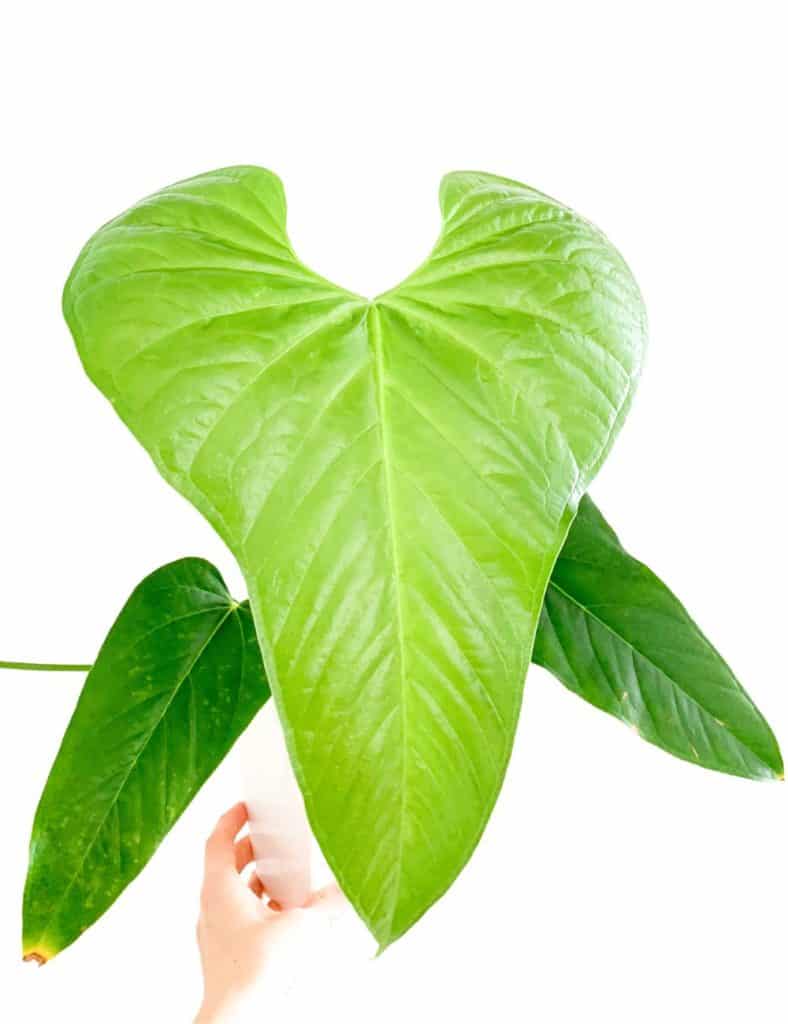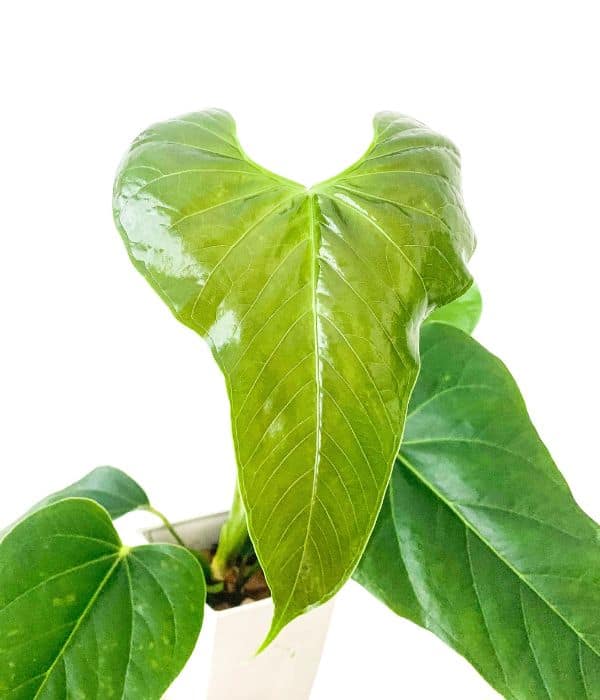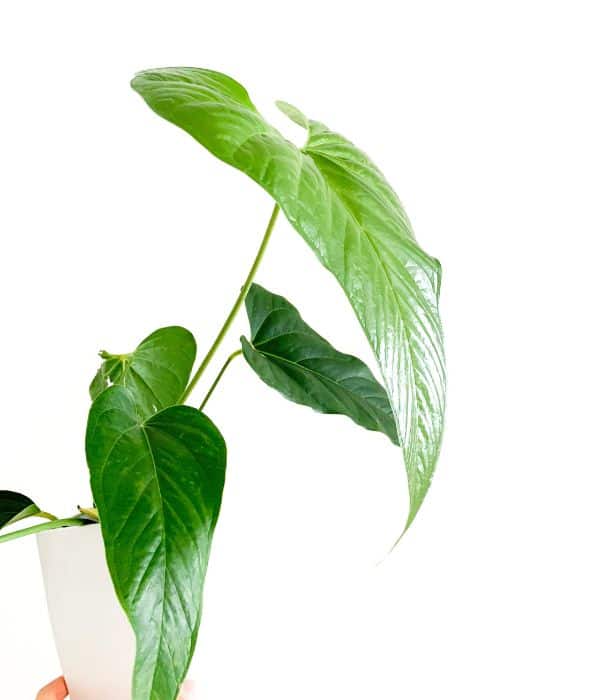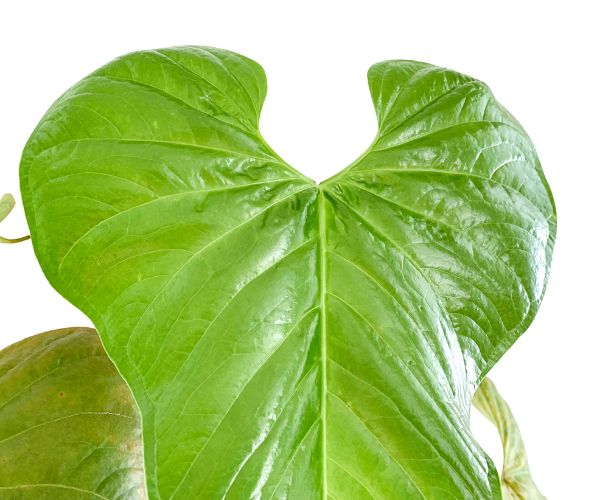Anthurium Effusilobum – the unknown anthurium worth knowing.
If you’re looking for an unusual aroid to grow, Anthurium effusilobum has you covered. The leaves can grow to massive sizes, and their shape will be a conversation starter with your friends. Your only worry with this amazing aroid will be whether you have enough space for it.

ABOUT ANTHURIUM EFFUSILOBUM CROAT
Anthurium Effusilobum Croat is a species in the Araceae family native to Ecuador and Peru. In its natural habitat of tropical rainforest, it’s been spotted growing both terrestrial and as an epiphyte.
It belongs to a relatively small section of Belolonchium and is unlikely to be crossed with other more commonly available anthuriums in cultivation, such as Anthurium magnificum, forgetii, or warocqueanum. They all belong to the Cardiolonchium section and are frequently crossed, producing magnificent hybrids.
As with most aroids, the inflorescence is underwhelming, but the leaves steal the show!

Anthurium Effusilobum leaves make it a highly desirable aroid
Anthurium effusilobum leaves will make you want it immediately. The eye-catching lobed leaves with undulated margins are spectacular. And the ribbed leaf texture adds extra visual interest to this stunning plant. The leaves are light green and glossy as they emerge, becoming more matte as they harden off. I love to watch them as they expand over the days.
The leaves grow upwards but then spread out, making it quite challenging to place. The current spread of the leaves is about 1m.
Unlike more velvety types of anthuriums (think magnificum, crystallinum, or queen anthurium), effusilobum leaves expand perfectly without tears. It’s because the leaves are much thinner than the velvet anthuriums.

Anthurium Effusilobum Seedlings
The juvenile leaves on effusilobum seedlings look different from those on mature specimens. This is very common with aroids in general. The leaf shape on seedlings doesn’t resemble mature specimens at all!
Some say that juvenile plants are nothing special, but I find the maturing process fascinating when a seedling transforms into a beautiful specimen.

HOW TO CARE FOR ANTHURIUM EFFUSILOBUM
Anthurium effusilobum is one of the easiest anthuriums to grow, in my experience. It was one of the first anthuriums I acquired and since it’s still around says a lot about its hardiness. I have yet to repot it in over 1.5 years.
AROID MIX
I grow it in my standard aroid mix, which is chunky and very well-draining. This particular species’ roots aren’t as thick as those of Anthurium clarinervium or magnificum, so you can opt for a more fine mix.
I’ve written extensive guides on anthurium potting mixes; you can refer to the blog on crystallinum care or queen anthurium.

WATER
As long as you don’t overwater it, you’ll be fine. And if you pot it in a well-draining mix, you can forget about overwatering. Since this anthurium I grow in a tall white plastic pot, I judge when to water it by the weight. It is super light when dry, so it’s my cue to give it a drink.
LIGHT
I used to grow it on a shelf under grow lights, but its growth pattern made it impossible to continue on the shelf after it grew more than three leaves. Giving it bright, indirect light will thrive and reward you with perfect new leaves.
TEMPERATURE AND HUMIDITY
It is found in nature in the higher elevations in Ecuador, so presumably, it prefers slightly cooler temperatures. Nevertheless, it grows in tropical forests and requires warm temperatures and high humidity all year round. I grow mine at average room temperature in about 55% humidity, and it thrives.
FERTILIZER
Anthurium effusilobum needs regular fertilizing to sustain those magnificent leaves. I use slow-release fertilizer (N15-P8-K11). I noticed faster new growth and bigger leaves when supplementing slow-release fertilizer with a weak solution of liquid fertilizer.
If you’re looking for an interesting, rare aroid, try growing anthurium effusilobum. It won’t disappoint.
Who wants to be boring when you can have this gorgeous plant?
And be sure to check out other blogs on my website for more information on growing amazing anthurium species.
You may also be interested in:
Anthurium Lineolatum: A Stunning Aroid
6 Rare Anthurium Species You’ll Want to Grow

